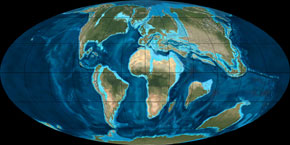Environment

This scene depicts the subtropical forest surrounding the Eocene Green River Lake system, in what is now southwestern Wyoming. The forest is composed of deciduous hardwood trees, as well as palms and early cacti. These lush surroundings supported a diverse fauna of mammals, both on the ground and in the trees, including early rodents and primates. Two perissodactyls are present…. and an early relative of the horse, Orohippus (right). Rob Barber\AMNH.
The mass extinctions that mark the end of the Cretaceous, 65 million years ago, are familiar to many people and are often viewed as one of the most important events in the history of life on Earth. It is true that the K-T Boundary Extinctions, as scientists call them, involved the loss of many spectacular creatures, most famously the large dinosaurs and marine reptiles. What is less well known is that, these extinctions apart, the environment of the planet after the K-T Boundary was much as it had been for the previous 60 million years. This was a world that would be unfamiliar to us – much warmer and more humid, with no polar ice-caps and dense forests covering much of the land.
In the aftermath of the extinction, mammals would evolve and diversify into a wide variety of forms. But they would have to cope with a series of enormous climatic upheavals which began around 55 million years ago. The temperature of the Earth dropped precipitately; new types of plant and new habitats arose; and the evolution of our own species, 200,000 years ago, has had massive effects on the planet’s biota that are still going on today. We will explore these changes through the evolutionary history of one group of mammals, the perissodactyls, looking at how this history has been shaped by long-term changes in the Earth’s climate, and how the climate changes that we are causing by our activities compare with these.

View of climate change extending back through the last 540 million years, including many cycles of change from warm to cold and back again. In this section, we will be focusing on the last 65 million years of this graph. Wikimedia Creative Commons

This graph of climate change over the last 65 million years has been divided into 5 intervals. Click on each interval below to explore changes in climate and their effects on the Earth’s biota.


